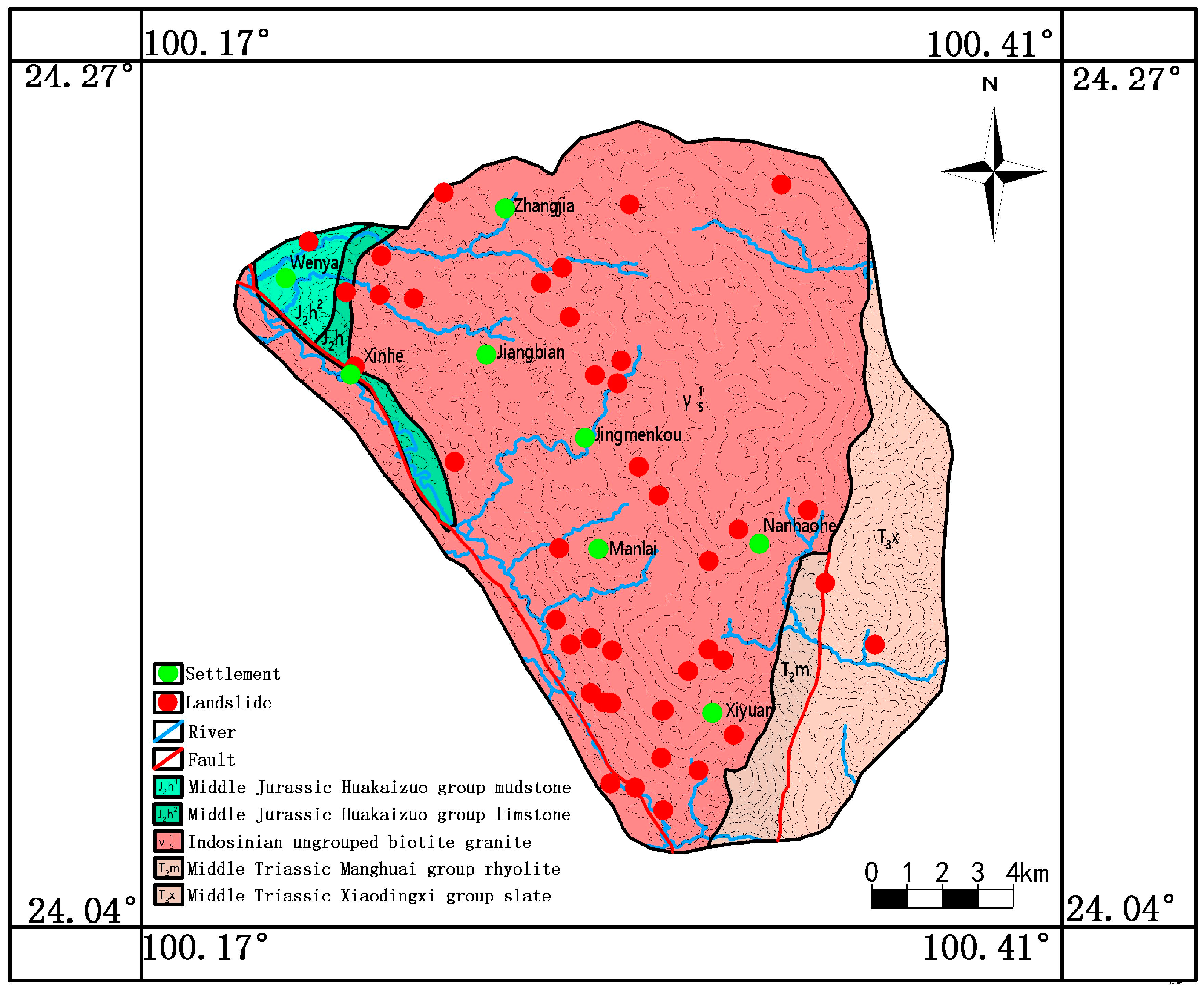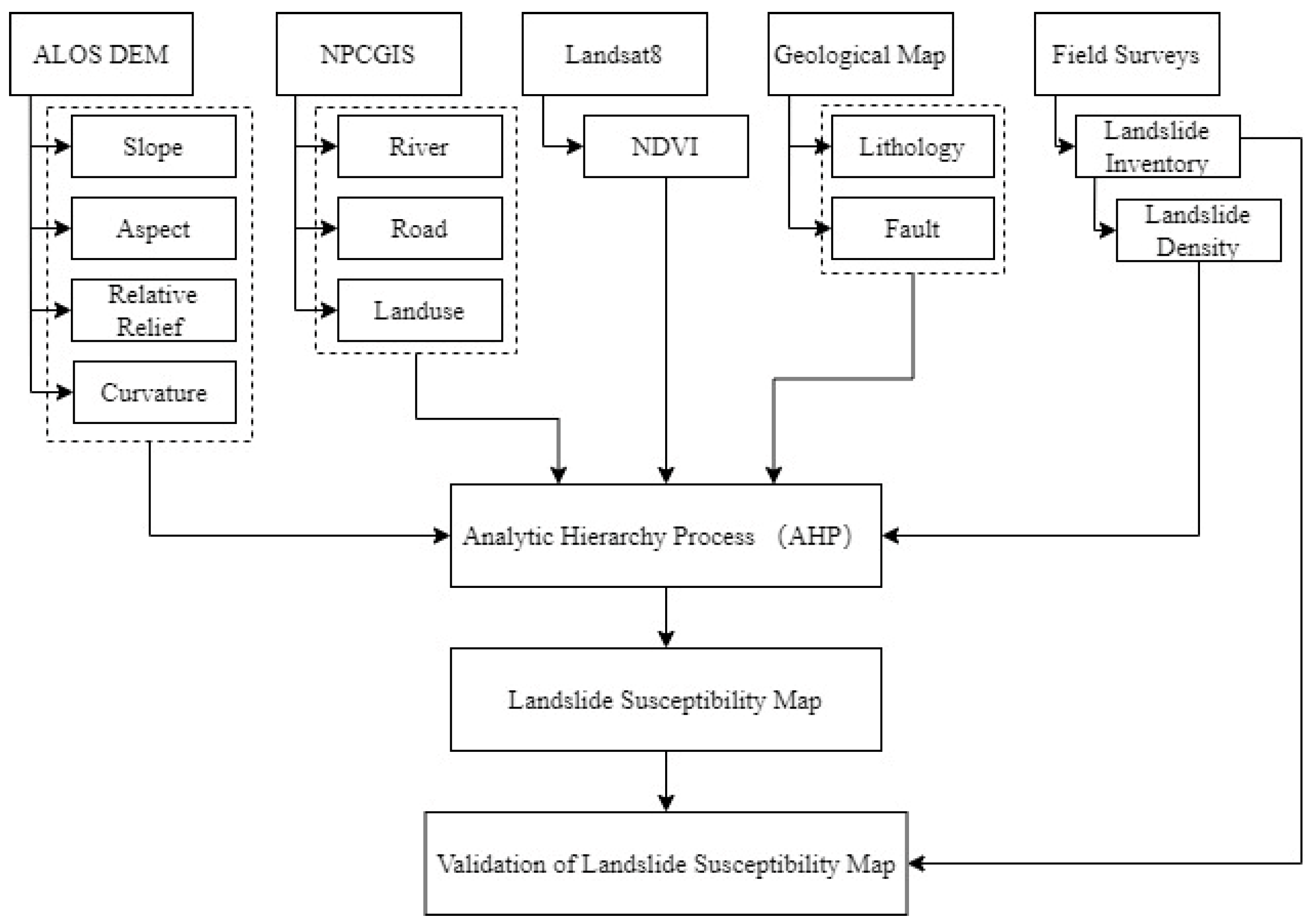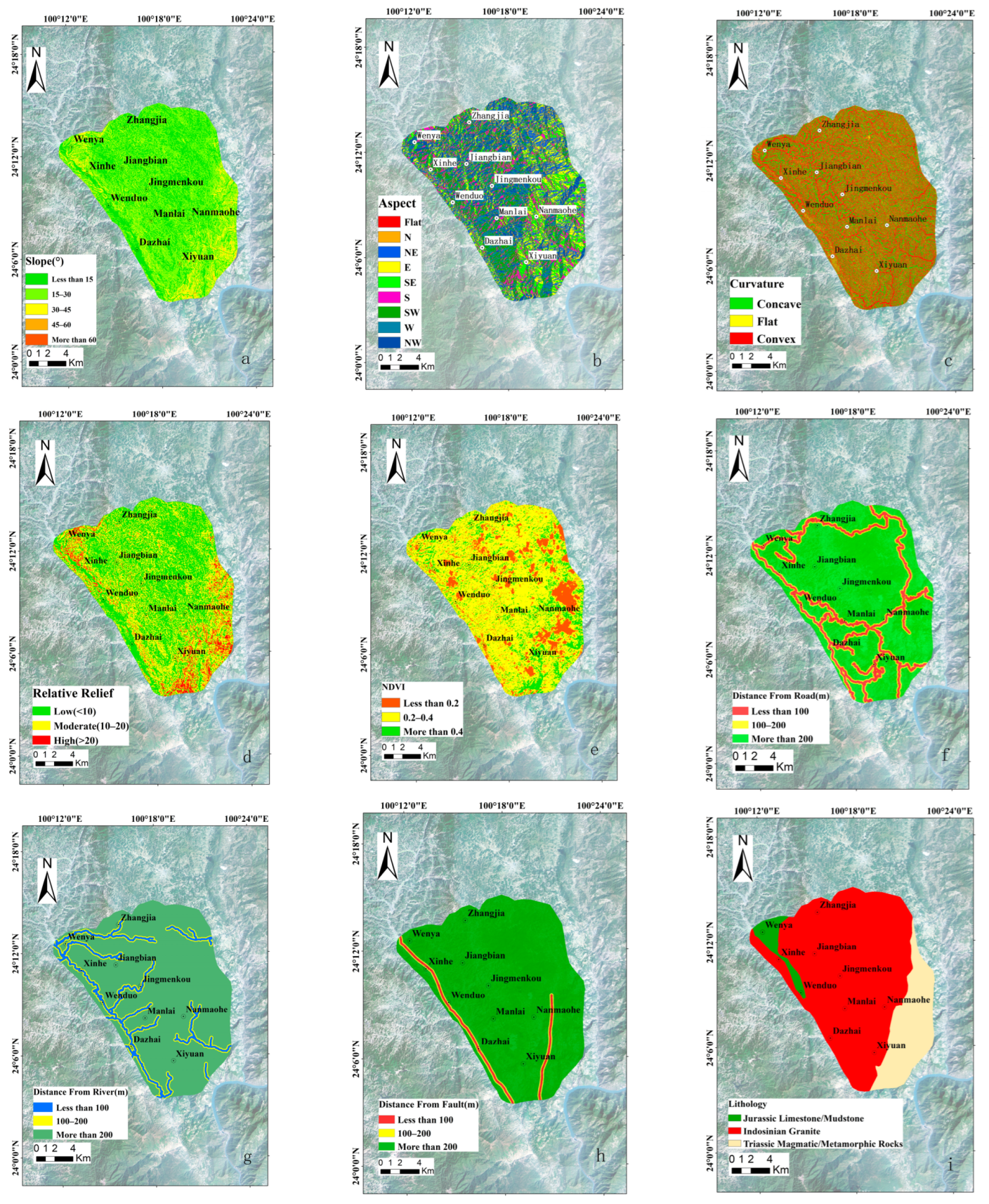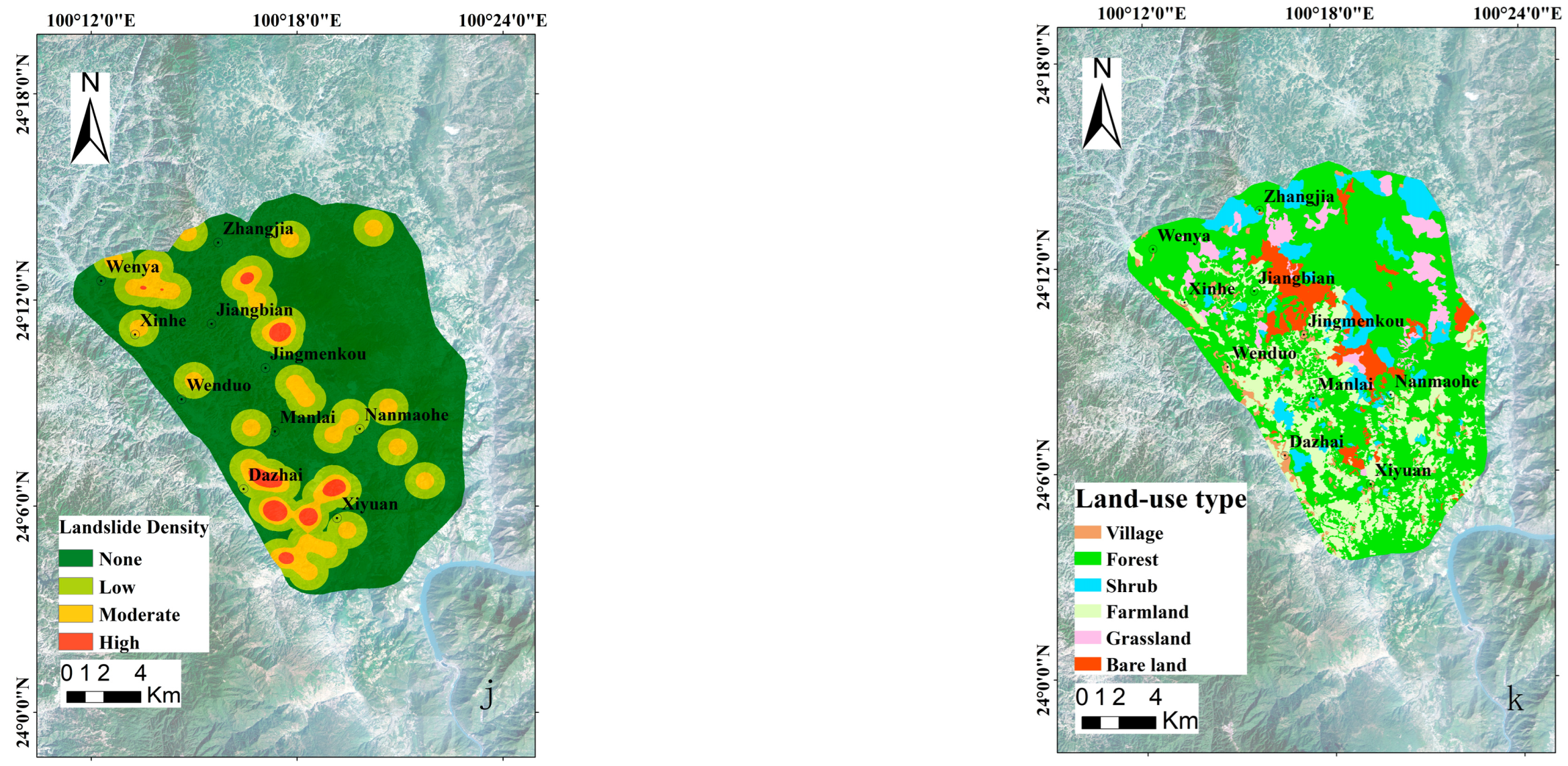Landslide Susceptibility Assessment Using the Analytic Hierarchy Process (AHP): A Case Study of a Construction Site for Photovoltaic Power Generation in Yunxian County, Southwest China
Abstract
1. Introduction
- The study region in the present research included only 1 township and 15 surrounding villages. The data on the landslide points were obtained from the 6-month-long field survey conducted by the project team, and a total of 42 disaster sites were recorded. The scope of the study region was small, and the samples of the landslide points were inadequate. Therefore, the supplementation and correction of the collected data by experienced experts were necessary.
- The data on the landslide points in the study region were recorded in the form of points.
- Several experts from the project team were involved in the present study, and the analytic hierarchy process (AHP) was adopted to ensure the consistency of the weights assigned by these experts based on their combined experience to prevent any conflict of opinions [33].
- The use of the analytic hierarchy process ensured an improvement in the evaluation accuracy through weight adjustment.
2. Materials and Methods
2.1. Study Region
2.2. Geological Setting
2.3. Landslide Point Data
2.4. Assessment Factors and Methods
2.4.1. Slope
2.4.2. Slope Aspect
2.4.3. Curvature
2.4.4. Relative Relief
2.4.5. NDVI
2.4.6. Distance from the Road
2.4.7. Distance from the River
2.4.8. Distance from the Fault
2.4.9. Lithology
2.4.10. Landslide Density
2.4.11. Land-Use Type
2.5. Analytic Hierarchy Process
3. Results
4. Discussion
5. Conclusions
- (1)
- The analytic hierarchy process (AHP) can be well applied to the evaluation and zoning mapping of landslide susceptibility. The results show that 23.16% of the study area is located in moderate-susceptibility and high-susceptibility areas, and 69.05% of landslides occur in moderate-susceptibility and high-susceptibility areas. At the same time, 51.22% of the construction land is distributed in moderate-susceptibility and high-susceptibility areas. Special attention should be paid to the protection of geological landslides during construction and operation.
- (2)
- By comparing factors, it is found that the presence of a factor with high weight or factors without high weight is not enough for areas with occasional landslides to be classified as moderate- or high-susceptibility zones. The characteristics of the moderate- and high-susceptibility zones show that two or more factors with high weight and their influence areas overlap, usually accompanied by intensive landslide occurrence.
- (3)
- The ROC curve verified that the susceptibility assessment results based on AHP are accurate, whose accuracy was 0.845. The research results depend on the selected assessment factors and their weights. Appropriate adjustment of the selected factors and their weights can improve the accuracy. The results of this study can provide a decision-making basis for the design, construction, and geological disaster prevention teams or risk engineers involved in the construction and operation of photovoltaic projects, as well as a method reference for the landslide susceptibility evaluation of similar mountain engineering construction projects in the future.
Author Contributions
Funding
Institutional Review Board Statement
Informed Consent Statement
Data Availability Statement
Conflicts of Interest
References
- China-Electricity, C. Report on Analysis and Forecast of Power Supply and Demand in China in 2021–2022. 2022. Available online: https://cec.org.cn/detail/index.html?3-293398 (accessed on 5 March 2023).
- Tao, Y.; Wu, Y.; Wu, M.; Luo, X.; He, F.; Gao, R.; Zhang, L. Multi-criteria decision making for comprehensive benefits assessment of photovoltaic poverty alleviation project under sustainability perspective: A case study in Yunnan, China. J. Clean. Prod. 2022, 346, 131175. [Google Scholar] [CrossRef]
- Yang, Y.; Yan, X.; Wang, X. The Characteristics and Formation of Geological Hazards in Yunnan Province. J. Catastrophol. 2021, 36, 131–139. [Google Scholar]
- Hongbin, Z. Characteristics and Hazards of Mountainous Geological Hazards in Yunnan Province. Master’s Thesis, Kunming University of Science and Technology, Kunming, China, 2005. Available online: https://kns.cnki.net/kcms2/article/abstract?v=u1RXSVo1P2b3QvNiAHcZFf4bZrl4kaSmhfCs-2p6ik68DTE9BWvMNZw84JkfKb-Gt4YgUqTDajpfK4RLrdfEXJDrYhj2WWAo7E24ud5j2gUj4LT2pgLh1A==&uniplatform=NZKPT&language=CHS (accessed on 4 March 2023).
- Hongwu, Z. Geological Disaster Investigation and Regionalization Report in Yunxian County, Yunnan Province; National Geological Archives: Beijing, China, 2005; Available online: https://www.ngac.cn/dzzlfw_sjgl/d2d/dse/category/detail.do?method=cdetail&_id=102_122472&tableCode=ty_qgg_edmk_t_ajxx&categoryCode=dzzlk (accessed on 5 March 2023).
- Pradhan, S.; Toll, D.G.; Rosser, N.J.; Brain, M.J. An investigation of the combined effect of rainfall and road cut on landsliding. Eng. Geol. 2022, 307, 106787. [Google Scholar] [CrossRef]
- Fayaz, M.; Meraj, G.; Khader, S.A.; Farooq, M. ARIMA and SPSS statistics based assessment of landslide occurrence in western Himalayas. Environ. Chall. 2022, 9, 100624. [Google Scholar] [CrossRef]
- Carrara, A.; Pike, R.J. GIS technology and models for assessing landslide hazard and risk. Geomorphology 2008, 94, 257–260. [Google Scholar] [CrossRef]
- Lin, J.; Chen, W.; Qi, X.; Hou, H. Risk assessment and its influencing factors analysis of geological hazards in typical mountain environment. J. Clean. Prod. 2021, 309, 127077. [Google Scholar] [CrossRef]
- Ma, C.; Wang, Y.; Hu, K.; Du, C.; Yang, W. Rainfall intensity–duration threshold and erosion competence of debris flows in four areas affected by the 2008 Wenchuan earthquake. Geomorphology 2017, 282, 85–95. [Google Scholar] [CrossRef]
- Bragagnolo, L.; da Silva, R.V.; Grzybowski, J.M.V. Landslide susceptibility mapping with r.landslide: A free open-source GIS-integrated tool based on Artificial Neural Networks. Environ. Model. Softw. 2020, 123, 104565. [Google Scholar] [CrossRef]
- Tan, Q.; Bai, M.; Zhou, P.; Hu, J.; Qin, X. Geological hazard risk assessment of line landslide based on remotely sensed data and GIS. Measurement 2021, 169, 108370. [Google Scholar] [CrossRef]
- Bera, S.; Guru, B.; Oommen, T. Indicator-based approach for assigning physical vulnerability of the houses to landslide hazard in the Himalayan region of India. Int. J. Disaster Risk Reduct. 2020, 50, 101891. [Google Scholar] [CrossRef]
- Zou, Q.; Jiang, H.; Cui, P.; Zhou, B.; Jiang, Y.; Qin, M.; Liu, Y.; Li, C. A new approach to assess landslide susceptibility based on slope failure mechanisms. Catena 2021, 204, 105388. [Google Scholar] [CrossRef]
- Reichenbach, P.; Rossi, M.; Malamud, B.D.; Mihir, M.; Guzzetti, F. A review of statistically-based landslide susceptibility models. Earth-Sci. Rev. 2018, 180, 60–91. [Google Scholar] [CrossRef]
- Barredo, J.; Benavides, A.; Hervás, J.; van Westen, C.J. Comparing heuristic landslide hazard assessment techniques using GIS in the Tirajana basin, Gran Canaria Island, Spain. Int. J. Appl. Earth Obs. Geoinf. 2000, 2, 9–23. [Google Scholar] [CrossRef]
- Grabowski, D.; Laskowicz, I.; Małka, A.; Rubinkiewicz, J. Geoenvironmental conditioning of landsliding in river valleys of lowland regions and its significance in landslide susceptibility assessment: A case study in the Lower Vistula Valley, Northern Poland. Geomorphology 2022, 419, 108490. [Google Scholar] [CrossRef]
- Yilmaz, I. Landslide susceptibility mapping using frequency ratio, logistic regression, artificial neural networks and their comparison: A case study from Kat landslides (Tokat—Turkey). Comput. Geosci. 2009, 35, 1125–1138. [Google Scholar] [CrossRef]
- Pradhan, B.; Lee, S. Landslide susceptibility assessment and factor effect analysis: Backpropagation artificial neural networks and their comparison with frequency ratio and bivariate logistic regression modelling. Environ. Model. Softw. 2010, 25, 747–759. [Google Scholar] [CrossRef]
- Khan, H.; Shafique, M.; Khan, M.A.; Bacha, M.A.; Shah, S.U.; Calligaris, C. Landslide susceptibility assessment using Frequency Ratio, a case study of northern Pakistan. Egypt. J. Remote Sens. Space Sci. 2019, 22, 11–24. [Google Scholar] [CrossRef]
- Goyes-Peñafiel, P.; Hernandez-Rojas, A. Landslide susceptibility index based on the integration of logistic regression and weights of evidence: A case study in Popayan, Colombia. Eng. Geol. 2021, 280, 105958. [Google Scholar] [CrossRef]
- Zhao, Z.; He, Y.; Yao, S.; Yang, W.; Wang, W.; Zhang, L.; Sun, Q. A comparative study of different neural network models for landslide susceptibility mapping. Adv. Space Res. 2022, 70, 383–401. [Google Scholar] [CrossRef]
- Alsabhan, A.H.; Singh, K.; Sharma, A.; Alam, S.; Pandey, D.D.; Rahman, S.A.S.; Khursheed, A.; Munshi, F.M. Landslide susceptibility assessment in the Himalayan range based along Kasauli–Parwanoo road corridor using weight of evidence, information value, and frequency ratio. J. King Saud Univ.-Sci. 2022, 34, 101759. [Google Scholar] [CrossRef]
- Sonker, I.; Tripathi, J.N.; Singh, A.K. Landslide susceptibility zonation using geospatial technique and analytical hierarchy process in Sikkim Himalaya. Quat. Sci. Adv. 2021, 4, 100039. [Google Scholar] [CrossRef]
- Abedi Gheshlaghi, H.; Feizizadeh, B. An integrated approach of analytical network process and fuzzy based spatial decision making systems applied to landslide risk mapping. J. Afr. Earth Sci. 2017, 133, 15–24. [Google Scholar] [CrossRef]
- Ali, S.A.; Parvin, F.; Vojteková, J.; Costache, R.; Linh, N.T.T.; Pham, Q.B.; Vojtek, M.; Gigović, L.; Ahmad, A.; Ghorbani, M.A. GIS-based landslide susceptibility modeling: A comparison between fuzzy multi-criteria and machine learning algorithms. Geosci. Front. 2021, 12, 857–876. [Google Scholar] [CrossRef]
- Panchal, S.; Shrivastava, A.K. A Comparative Study of Frequency Ratio, Shannon’s Entropy and Analytic Hierarchy Process (AHP) Models for Landslide Susceptibility Assessment. ISPRS Int. J. Geo-Inf. 2021, 10, 603. [Google Scholar] [CrossRef]
- Mandal, B.; Mandal, S. Analytical hierarchy process (AHP) based landslide susceptibility mapping of Lish river basin of eastern Darjeeling Himalaya, India. Adv. Space Res. 2018, 62, 3114–3132. [Google Scholar] [CrossRef]
- Kayastha, P.; Dhital, M.R.; De Smedt, F. Application of the analytical hierarchy process (AHP) for landslide susceptibility mapping: A case study from the Tinau watershed, west Nepal. Comput. Geosci. 2013, 52, 398–408. [Google Scholar] [CrossRef]
- Nsangou, D.; Kpoumié, A.; Mfonka, Z.; Ngouh, A.N.; Fossi, D.H.; Jourdan, C.; Mbele, H.Z.; Mouncherou, O.F.; Vandervaere, J.-P.; Ngoupayou, J.R.N. Urban flood susceptibility modelling using AHP and GIS approach: Case of the Mfoundi watershed at Yaoundé in the South-Cameroon plateau. Sci. Afr. 2022, 15, e01043. [Google Scholar] [CrossRef]
- Das, S. Flood susceptibility mapping of the Western Ghat coastal belt using multi-source geospatial data and analytical hierarchy process (AHP). Remote Sens. Appl. Soc. Environ. 2020, 20, 100379. [Google Scholar] [CrossRef]
- Taheri, K.; Gutiérrez, F.; Mohseni, H.; Raeisi, E.; Taheri, M. Sinkhole susceptibility mapping using the analytical hierarchy process (AHP) and magnitude–frequency relationships: A case study in Hamadan province, Iran. Geomorphology 2015, 234, 64–79. [Google Scholar] [CrossRef]
- Saaty, R.W. The analytic hierarchy process—What it is and how it is used. Math. Model. 1987, 9, 161–176. [Google Scholar] [CrossRef]
- Cong, F.; Wu, F.-Y.; Li, W.-C.; Mou, C.-L.; Huang, X.-M.; Wang, B.-D.; Hu, F.-Y.; Peng, Z.-M. Origin of the Triassic Lincang granites in the southeastern Tibetan Plateau: Crystallization from crystal mush. Lithos 2020, 360–361, 105452. [Google Scholar] [CrossRef]
- Hewitt, K.; Clague, J.J.; Orwin, J.F. Legacies of catastrophic rock slope failures in mountain landscapes. Earth-Sci. Rev. 2008, 87, 1–38. [Google Scholar] [CrossRef]
- Raghuvanshi, T.K.; Ibrahim, J.; Ayalew, D. Slope stability susceptibility evaluation parameter (SSEP) rating scheme—An approach for landslide hazard zonation. J. Afr. Earth Sci. 2014, 99, 595–612. [Google Scholar] [CrossRef]
- Kafle, L.; Xu, W.-J.; Zeng, S.-Y.; Nagel, T. A numerical investigation of slope stability influenced by the combined effects of reservoir water level fluctuations and precipitation: A case study of the Bianjiazhai landslide in China. Eng. Geol. 2022, 297, 106508. [Google Scholar] [CrossRef]
- Tang, Y.; Feng, F.; Guo, Z.; Feng, W.; Li, Z.; Wang, J.; Sun, Q.; Ma, H.; Li, Y. Integrating principal component analysis with statistically-based models for analysis of causal factors and landslide susceptibility mapping: A comparative study from the loess plateau area in Shanxi (China). J. Clean. Prod. 2020, 277, 124159. [Google Scholar] [CrossRef]
- Tao, R. Risk Assessment of Geological Hazard in Pingshan County Based on GIS 2022; Hebei GEO University: Shijiazhuang, China, 2022. [Google Scholar] [CrossRef]
- Khaliq, A.H.; Basharat, M.; Riaz, M.T.; Riaz, M.T.; Wani, S.; Al-Ansari, N.; Le, L.B.; Linh, N.T.T. Spatiotemporal landslide susceptibility mapping using machine learning models: A case study from district Hattian Bala, NW Himalaya, Pakistan. Ain Shams Eng. J. 2023, 14, 101907. [Google Scholar] [CrossRef]
- Zhang, W.; Chen, W.; Ye, F.; Wang, S. Study of the distribution rules of landslides of Bailong River basin in Gansu Province. J. Eng. Geol. 2016, 24, 1135–1143. [Google Scholar]
- He, X.; Liao, X.; Zhang, L.; Zeng, Q. Clustering of landslide causal factors and road Engineering disturbance effect analysis in Bailong River basin. J. Eng. Geol. 2022, 30, 672–687. [Google Scholar] [CrossRef]
- Lingang, L. Study on the Mechanism of Bank Slope Instability Considering River Scouring 2019. Master’s Thesis, Chongqing Jiaotong University, Chongqing, China, 2019. [Google Scholar] [CrossRef]
- Lo, P.-C.; Lo, W.; Chiu, Y.-C.; Wang, T.-T. Movement characteristics of a creeping slope influenced by river erosion and aggradation: Study of Xinwulü River in southeastern Taiwan. Eng. Geol. 2021, 295, 106443. [Google Scholar] [CrossRef]
- Yin, Y.; Huang, B.; Wang, W.; Wei, Y.; Ma, X.; Ma, F.; Zhao, C. Reservoir-induced landslides and risk control in Three Gorges Project on Yangtze River, China. J. Rock Mech. Geotech. Eng. 2016, 8, 577–595. [Google Scholar] [CrossRef]
- Liu, Y.; Li, H.; Zheng, H.; Tan, F. Research progress and prospect of the relationship among active tectonics, earthquakes and geological disasters in China. J. Nat. Disasters 2022, 31, 1–14. [Google Scholar] [CrossRef]
- Florsheim, J.L.; Nichols, A. Landslide area probability density function statistics to assess historical landslide magnitude and frequency in coastal California. Catena 2013, 109, 129–138. [Google Scholar] [CrossRef]
- Wei, S.; Luan, Q.; Hunag, C.; Gu, X. Review and prospects on researches on soft measures of land-use planning in prevention and control of geological disasters. J. Nat. Disasters 2014, 23, 159–165. [Google Scholar] [CrossRef]
- Panchal, S.; Shrivastava, A.K. Landslide hazard assessment using analytic hierarchy process (AHP): A case study of National Highway 5 in India. Ain Shams Eng. J. 2022, 13, 101626. [Google Scholar] [CrossRef]
- Nie, X.; Yang, J. The determination of afm abrasive flow boundary conditions. Mach. Manuf. 2001, 33, 9–11. Available online: https://www.scopus.com/inward/record.uri?eid=2-s2.0-84928401405&partnerID=40&md5=7fd4dd4c67a8a430e3ac0e43253c38bc (accessed on 6 February 2023).
- El Jazouli, A.; Barakat, A.; Khellouk, R.; Rais, J.; El Baghdadi, M. Remote sensing and GIS techniques for prediction of land use land cover change effects on soil erosion in the high basin of the Oum Er Rbia River (Morocco). Remote Sens. Appl. Soc. Environ. 2019, 13, 361–374. [Google Scholar] [CrossRef]
- Patriche, C.V.; Pirnau, R.; Grozavu, A.; Rosca, B. A Comparative Analysis of Binary Logistic Regression and Analytical Hierarchy Process for Landslide Susceptibility Assessment in the Dobrov River Basin, Romania. Pedosphere 2016, 26, 335–350. [Google Scholar] [CrossRef]
- Abedini, M.; Ghasemyan, B.; Mogaddam, M.H.R. Landslide susceptibility mapping in Bijar city, Kurdistan Province, Iran: A comparative study by logistic regression and AHP models. Environ. Earth Sci. 2017, 76, 14. [Google Scholar] [CrossRef]
- Yu, C.L.; Chen, J. Application of a GIS-Based Slope Unit Method for Landslide Susceptibility Mapping in Helong City: Comparative Assessment of ICM, AHP, and RF Model. Symmetry-Basel 2020, 12, 1848. [Google Scholar] [CrossRef]








| Extracted Data | Scale | Source |
|---|---|---|
| Landslide data | Field Survey | |
| Topographic elements (aspect, slope, curvature, relative relief) | ALOS-Digital Elevation Model | |
| NDVI | Landsat 8 | |
| Geographical elements (roads, rivers, land-use type) | 1:10,000 | National Platform for Common Geospatial Information Services (NPCGIS) |
| Geological elements (fault, stratigraphic lithology) | 1:200,000 | Geological map for Yunxian County |
| Scale Preference | Definition | Explanation |
|---|---|---|
| 1 | Equally Important | Both factors are equally important |
| 3 | Slightly Important | The factor has a few more effects than the other one |
| 5 | More Important | One factor is more effective as compared to the other one |
| 7 | Particularly Important | A factor has higher importance than the other one |
| 9 | Most Important | A factor has the highest possibility of affecting the occurrence of landslide over the other factor |
| 2,4,6,8 | Intermediate Values | The degree of importance is between the above scales |
| Factors | Slope | Aspect | Curvature | Relative Relief | NDVI | Road Distance | River Distance | Fault Distance | Lithology | Density | Land Use | Weightage |
|---|---|---|---|---|---|---|---|---|---|---|---|---|
| Slope | 1 | 0.037 | ||||||||||
| Aspect | 0.2 | 1 | 0.015 | |||||||||
| Curvature | 0.33 | 2 | 1 | 0.022 | ||||||||
| Relative Relief | 0.5 | 2 | 1 | 1 | 0.026 | |||||||
| NDVI | 5 | 7 | 5 | 3 | 1 | 0.059 | ||||||
| Road Distance | 3 | 5 | 3 | 3 | 5 | 1 | 0.099 | |||||
| River Distance | 3 | 5 | 3 | 3 | 3 | 1 | 1 | 0.091 | ||||
| Fault Distance | 2 | 5 | 4 | 4 | 2 | 1 | 1 | 1 | 0.068 | |||
| Lithology | 5 | 7 | 9 | 5 | 3 | 3 | 3 | 5 | 1 | 0.168 | ||
| Density | 5 | 7 | 8 | 5 | 3 | 2 | 2 | 3 | 2 | 1 | 0.173 | |
| Land use | 7 | 9 | 8 | 7 | 5 | 2 | 3 | 3 | 3 | 2 | 1 | 0.241 |
| Factors/Subfactors | 1 | 2 | 3 | 4 | 5 | 6 | 7 | 8 | 9 | AHP Weightage |
|---|---|---|---|---|---|---|---|---|---|---|
| Slope (°) | ||||||||||
| 0–15 | 1 | 0.033 | ||||||||
| 15–30 | 3 | 1 | 0.064 | |||||||
| 30–45 | 5 | 3 | 1 | 0.130 | ||||||
| 45–60 | 7 | 5 | 3 | 1 | 0.264 | |||||
| More than 60 | 9 | 7 | 5 | 3 | 1 | 0.510 | ||||
| CR | 0.049 | |||||||||
| Aspect | ||||||||||
| flat | 1 | 0.024 | ||||||||
| North | 2 | 1 | 0.049 | |||||||
| Northeast | 7 | 4 | 1 | 0.217 | ||||||
| East | 4 | 2 | 0.33 | 1 | 0.089 | |||||
| Southeast | 9 | 8 | 3 | 4 | 1 | 0.295 | ||||
| South | 5 | 3 | 0.5 | 2 | 0.25 | 1 | 0.135 | |||
| Southwest | 4 | 2 | 0.25 | 1 | 2 | 0.5 | 1 | 0.108 | ||
| West | 3 | 0.5 | 0.25 | 0.5 | 0.14 | 0.33 | 0.5 | 1 | 0.049 | |
| Northwest | 2 | 1 | 0.14 | 0.33 | 0.12 | 0.25 | 0.33 | 0.5 | 1 | 0.024 |
| CR | 0.070 | |||||||||
| Curvature | ||||||||||
| Flat (−0.5–0.5) | 1 | 0.072 | ||||||||
| Concave (<0.5) | 7 | 1 | 0.650 | |||||||
| Convex (>0.5) | 5 | 0.33 | 1 | 0.278 | ||||||
| CR | 0.046 | |||||||||
| Relative Relief (m) | ||||||||||
| Low (<10) | 1 | 0.105 | ||||||||
| Moderate (10–20) | 3 | 1 | 0.258 | |||||||
| High (>20) | 5 | 3 | 1 | 0.637 | ||||||
| CR | 0.0284 | |||||||||
| NDVI | ||||||||||
| Low (<0.2) | 1 | 0.651 | ||||||||
| Moderate (0.2–0.4) | 3 | 1 | 0.126 | |||||||
| High (>0.4) | 5 | 3 | 1 | 0.223 | ||||||
| CR | 0.0284 | 0.017 | ||||||||
| Distance from Road (m) | ||||||||||
| Low (<100) | 1 | 0.806 | ||||||||
| 100–200 | 0.12 | 1 | 0.120 | |||||||
| More than 200 | 0.11 | 0.5 | 1 | 0.074 | ||||||
| CR | 0.019 | 0.019 | ||||||||
| Distance from River (m) | ||||||||||
| Less than 100 | 1 | 0.740 | ||||||||
| 100–200 | 0.2 | 1 | 0.167 | |||||||
| More than 200 | 0.14 | 0.5 | 1 | 0.094 | ||||||
| CR | 0.006 | |||||||||
| Distance from Fault | ||||||||||
| Less than 100 | 1 | 0.637 | ||||||||
| 100–200 | 0.33 | 1 | 0.259 | |||||||
| More than 200 | 0.2 | 0.33 | 1 | 0.104 | ||||||
| CR | 0.028 | |||||||||
| Lithology | ||||||||||
| Indosinian granite | 1 | 0.258 | ||||||||
| Jurassic limestone/mudstone | 3 | 1 | 0.637 | |||||||
| Triassic magmatic/metamorphic rocks | 0.33 | 0.2 | 1 | 0.105 | ||||||
| CR | 0.028 | |||||||||
| Disaster Density | ||||||||||
| None | 1 | 0.046 | ||||||||
| Low | 3 | 1 | 0.115 | |||||||
| Moderate | 7 | 3 | 1 | 0.309 | ||||||
| High | 9 | 5 | 2 | 1 | 0.529 | |||||
| CR | 0.008 | |||||||||
| Land Use | ||||||||||
| Village | 1 | 0.022 | ||||||||
| Shrubland | 0.33 | 1 | 0.039 | |||||||
| Farmland | 5 | 5 | 1 | 0.064 | ||||||
| Grassland | 3 | 0.33 | 0.33 | 1 | 0.108 | |||||
| Bare land | 7 | 8 | 3 | 5 | 1 | 0.041 | ||||
| Forest | 0.20 | 0.33 | 0.20 | 0.20 | 0.14 | 1 | 0.154 | |||
| CR | 0.071 |
Disclaimer/Publisher’s Note: The statements, opinions and data contained in all publications are solely those of the individual author(s) and contributor(s) and not of MDPI and/or the editor(s). MDPI and/or the editor(s) disclaim responsibility for any injury to people or property resulting from any ideas, methods, instructions or products referred to in the content. |
© 2023 by the authors. Licensee MDPI, Basel, Switzerland. This article is an open access article distributed under the terms and conditions of the Creative Commons Attribution (CC BY) license (https://creativecommons.org/licenses/by/4.0/).
Share and Cite
Zhou, J.; Tan, S.; Li, J.; Xu, J.; Wang, C.; Ye, H. Landslide Susceptibility Assessment Using the Analytic Hierarchy Process (AHP): A Case Study of a Construction Site for Photovoltaic Power Generation in Yunxian County, Southwest China. Sustainability 2023, 15, 5281. https://doi.org/10.3390/su15065281
Zhou J, Tan S, Li J, Xu J, Wang C, Ye H. Landslide Susceptibility Assessment Using the Analytic Hierarchy Process (AHP): A Case Study of a Construction Site for Photovoltaic Power Generation in Yunxian County, Southwest China. Sustainability. 2023; 15(6):5281. https://doi.org/10.3390/su15065281
Chicago/Turabian StyleZhou, Jinxuan, Shucheng Tan, Jun Li, Jian Xu, Chao Wang, and Hui Ye. 2023. "Landslide Susceptibility Assessment Using the Analytic Hierarchy Process (AHP): A Case Study of a Construction Site for Photovoltaic Power Generation in Yunxian County, Southwest China" Sustainability 15, no. 6: 5281. https://doi.org/10.3390/su15065281
APA StyleZhou, J., Tan, S., Li, J., Xu, J., Wang, C., & Ye, H. (2023). Landslide Susceptibility Assessment Using the Analytic Hierarchy Process (AHP): A Case Study of a Construction Site for Photovoltaic Power Generation in Yunxian County, Southwest China. Sustainability, 15(6), 5281. https://doi.org/10.3390/su15065281







